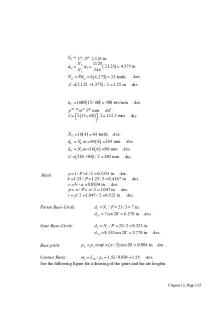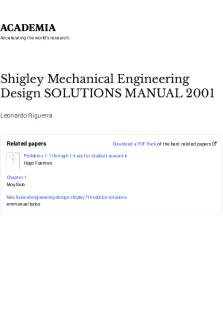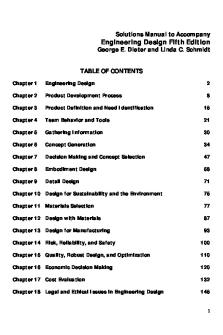Chapter 7 solutions solution manual shigleys mechanical engineering design PDF

| Title | Chapter 7 solutions solution manual shigleys mechanical engineering design |
|---|---|
| Author | Shahrukh Shaheedi |
| Course | Mechanical engineering |
| Institution | The University of Lahore |
| Pages | 45 |
| File Size | 1.5 MB |
| File Type | |
| Total Downloads | 44 |
| Total Views | 146 |
Summary
chapter 7 solutions are right here if anyone need them. Please download and enjoy....
Description
DE-Gerber, Eq. (7-10): A 4 K f M a 3 K fsTa 4 (2.2)(70) 3 (1.8)(45) 338.4 N m 2
2
2
2
B 4 K f Mm 3 K fs Tm 4 (2.2)(55) 3 (1.8)(35) 265.5 N m 2
2
2
6 8(2)(338.4) 2(265.5) 210 10 1 1 d 6 6 210 10 338.4 700 10 3 d = 25.85 (10 ) m = 25.85 mm Ans.
2
2
1/ 2
1/3
DE-elliptic, Eq. (7-12) can be shown to be 338.42 265.52 16(2) 2 2 210 10 6 560 106 3 d = 25.77 (10 ) m = 25.77 mm Ans. 16n d
1/3
1/3
A B Se2 Sy2 2
2
DE-Soderberg, Eq. (7-14) can be shown to be 16(2) 338.4 265.5 6 210 10 560 106 d = 27.70 (103) m = 27.70 mm Ans. 1/3
16 n A B d Se Sy
1/3
DE-Goodman: Eq. (7-8) can be shown to be 1/3
16(2) 338.4 265.5 6 210 106 700 10 3 d = 27.27 (10 ) m = 27.27 mm Ans. ________________________________________________________________________ Criterion d (mm) Compared to DE-Gerber DE-Gerber 25.85 DE-Elliptic 25.77 0.31% Lower Less conservative DE-Soderberg 27.70 7.2% Higher More conservative DE-Goodman 27.27 5.5% Higher More conservative ______________________________________________________________________________ 16 n A B d Se Sut
1/3
This problem has to be done by successive trials, since S e is a function of shaft size. The material is SAE 2340 for which S ut = 175 kpsi, S y = 160 kpsi, and H B ≥ 370. Chapter 7 - Rev. A, Page 1/45
Eq. (6-19), p. 287:
ka 2.70(175)0.265 0.69
Trial #1: Choose d r = 0.75 in Eq. (6-20), p. 288: Eq. (6-8), p.282: Eq. (6-18), p. 287:
kb 0.879(0.75)0.107 0.91
Se 0.5Sut 0.5 175 87.5 kpsi S e = 0.69 (0.91)(87.5) = 54.9 kpsi
dr d 2r 0.75 D 2 D / 20 0.65 D d 0.75 D r 1.15 in 0.65 0.65 D 1.15 r 0.058 in 20 20 Fig. A-15-14: d dr 2r 0.75 2(0.058) 0.808 in d 0.808 1.08 dr 0.75 0.058 r 0.077 dr 0.75 Kt = 1.9 Fig. 6-20, p. 295: r = 0.058 in, q = 0.90 Eq. (6-32), p. 295: K f = 1 + 0.90 (1.9 – 1) = 1.81 Fig. A-15-15: K ts = 1.5 Fig. 6-21, p. 296: r = 0.058 in, q s = 0.92 Eq. (6-32), p. 295: K fs = 1 + 0.92 (1.5 – 1) = 1.46 We select the DE-ASME Elliptic failure criteria, Eq. (7-12), with d as d r , and M m = T a = 0, 1/3
2 2 1/2 1.46(400) 16(2.5) 1.81(600) 3 dr 4 3 54.9 103 160 10 dr = 0.799 in
Trial #2: Choose d r = 0.799 in. kb 0.879(0.799)0.107 0.90
Se = 0.69 (0.90)(0.5)(175) = 54.3 kpsi d 0.799 D r 1.23 in 0.65 0.65 r = D / 20 = 1.23/20 = 0.062 in Chapter 7 - Rev. A, Page 2/45
Figs. A-15-14 and A-15-15: d dr 2r 0.799 2(0.062) 0.923 in d 0.923 1.16 d r 0.799 0.062 r 0.078 d r 0.799 With these ratios only slightly different from the previous iteration, we are at the limit of readability of the figures. We will keep the same values as before. Kt 1.9, Kts 1.5, q 0.90, qs 0.92 K f 1.81, K fs 1.46 Using Eq. (7-12) produces d r = 0.802 in. Further iteration produces no change. With d r = 0.802 in, 0.802 D 1.23 in 0.65 d 0.75(1.23) 0.92 in A look at a bearing catalog finds that the next available bore diameter is 0.9375 in. In nominal sizes, we select d = 0.94 in, D = 1.25 in, r = 0.0625 in Ans. ______________________________________________________________________________ 7-3
F cos 20(d / 2) = T A , F = 2 T A / ( d cos 20) = 2(340) / (0.150 cos 20) = 4824 N. The maximum bending moment will be at point C, with M C = 4824(0.100) = 482.4 N·m. Due to the rotation, the bending is completely reversed, while the torsion is constant. Thus, M a = 482.4 N·m, T m = 340 N·m, M m = T a = 0. For sharp fillet radii at the shoulders, from Table 7-1, K t = 2.7, and K ts = 2.2. Examining Figs. 6-20 and 6-21 (pp. 295 and 296 respectively) with Sut 560 MPa, conservatively estimate q = 0.8 and qs 0.9. These estimates can be checked once a specific fillet radius is determined. Eq. (6-32):
K f 1 0.8(2.7 1) 2.4 K fs 1 0.9(2.2 1) 2.1
(a) We will choose to include fatigue stress concentration factors even for the static analysis to avoid localized yielding. 1/2
Eq. (7-15):
2 32K M 2 16K fsTm f a max 3 3 3 d d
Chapter 7 - Rev. A, Page 3/45
Eq. (7-16):
1/ 2 d 3S y Sy 2 2 n 4 K f M a 3 K fsTm 16 max
Solving for d, 1/3
16 n 1/ 2 4( K f M a ) 2 3( K fsTa ) 2 d S y 16(2.5) 420 10 6
4 (2.4)(482.4) 3 (2.1)(340)
d = 0.0430 m = 43.0 mm (b)
2 1/ 2
2
1/3
Ans.
ka 4.51(560)0.265 0.84
Assume k b = 0.85 for now. Check later once a diameter is known. S e = 0.84(0.85)(0.5)(560) = 200 MPa Selecting the DE-ASME Elliptic criteria, use Eq. (7-12) with Mm Ta 0. 1/3
2 2 1/ 2 2.1(340) 16(2.5) 2.4(482.4) 3 d 4 6 420 10 6 200 10 0.0534 m 53.4 mm
With this diameter, we can refine our estimates for k b and q. Eq. (6-20):
kb 1.51d 0.157 1.51 53.4
0.157
0.81
Assuming a sharp fillet radius, from Table 7-1, r = 0.02d = 0.02 (53.4) = 1.07 mm. Fig. (6-20): Fig. (6-21):
q = 0.72 q s = 0.77
Iterating with these new estimates, Eq. (6-32): Eq. (6-18): Eq. (7-12):
K f = 1 + 0.72 (2.7 – 1) = 2.2 K fs = 1 + 0.77 (2.2 – 1) = 1.9 S e = 0.84(0.81)(0.5)(560) = 191 MPa d = 53 mm Ans.
Further iteration does not change the results. _____________________________________________________________________________
Chapter 7 - Rev. A, Page 4/45
7-4
We have a design task of identifying bending moment and torsion diagrams which are preliminary to an industrial roller shaft design. Let point C represent the center of the span of the roller.
FCy 30(8) 240 lbf FCz 0.4(240) 96 lbf T FCz (2) 96(2) 192 lbf in T 192 FBz 128 lbf 1.5 1.5 FBy FBz tan 20 128 tan 20 46.6 lbf
(a) xy-plane
M O 240(5.75) F Ay (11.5) 46.6(14.25) 0 240(5.75) 46.6(14.25) FAy 62.3 lbf 11.5 M A FOy (11.5) 46.6(2.75) 240(5.75) 0 240(5.75) 46.6(2.75) FOy 131.1 lbf 11.5
Bending moment diagram:
xz-plane
Chapter 7 - Rev. A, Page 5/45
MO 0 96(5.75) FAz (11.5) 128(14.25) 96(5.75) 128(14.25) FAz 206.6 lbf 11.5 M A 0 FOz (11.5) 128(2.75) 96(5.75) 96(5.75) 128(2.75) FOz 17.4 lbf 11.5
Bending moment diagram:
M C 1002 ( 754)2 761 lbf in M A ( 128)2 ( 352)2 375 lbf in
Torque: The torque is constant from C to B, with a magnitude previously obtained of 192 lbf·in. (b) xy-plane
2
2
M xy 131.1x 15 x 1.75 15 x 9.75 62.3 x 11.5
1
Bending moment diagram:
Chapter 7 - Rev. A, Page 6/45
M max = –516 lbf · in and occurs at 6.12 in. M C 131.1(5.75) 15(5.75 1.75)2 514 lbf in
This is reduced from 754 lbf · in found in part (a). The maximum occurs at x 6.12 in rather than C, but it is close enough. xz-plane
2
2
M xz 17.4x 6 x 1.75 6 x 9.75 206.6 x 11.5
1
Bending moment diagram:
Let Mnet M xy2 M xz2 Plot M net(x), 1.75 ≤ x ≤ 11.5 in M max = 516 lbf · in at x = 6.25 in Torque: The torque rises from 0 to 192 lbf·in linearly across the roller, then is constant to B. Ans. ______________________________________________________________________________ This is a design problem, which can have many acceptable designs. See the solution for Prob. 7-17 for an example of the design process. ______________________________________________________________________________ 7-5
Chapter 7 - Rev. A, Page 7/45
7-6
If students have access to finite element or beam analysis software, have them model the shaft to check deflections. If not, solve a simpler version of shaft for deflection. The 1 in diameter sections will not affect the deflection results much, so model the 1 in diameter as 1.25 in. Also, ignore the step in AB.
From Prob. 7-4, integrate M xy and M xz . xy plane, with dy/dx = y' 131.1 2 62.3 2 3 3 x 5 x 1.75 5 x 9.75 x 11.5 C1 2 2 131.1 3 5 5 62.3 4 4 3 EIy x x 1.75 x 9.75 x 11.5 C1 x C2 6 4 4 6 EIy
(1)
y 0 at x 0 From (1),
C2 0
y 0 at x 11.5 C1 1908.4 lbf in3 x = 0: EIy' = 1908.4 x = 11.5: EIy' = –2153.1
xz plane (treating z ) 17.4 2 206.6 2 3 3 x 2 x 1.75 2 x 9.75 x 11.5 C3 2 2 17.4 3 1 1 206.6 4 4 3 EIz x x 1.75 x 9.75 x 11.5 C 3x C 4 6 2 2 6 EIz
(2)
z 0 at x 0 From (2),
At O:
C4 0
z 0 at x 11.5 C3 8.975 lbf in3 x = 0: EIz' = 8.975 x = 11.5: EIz' = –683.5
EI 1908.42 8.9752 1908.4 lbf in3
Chapter 7 - Rev. A, Page 8/45
EI ( 2153.1)2 ( 683.5)2 2259.0 lbf in3 (dictates size)
At A:
n
2259
/ 64 1.25
30 10
6
4
0.000 628 rad
0.001 1.59 0.000 628
At gear mesh, B xy plane With I I 1 in section OCA, y A 2153.1/ EI1 Since y' B/A is a cantilever, from Table A-9-1, with I I2 in section AB Fx ( x 2l ) 46.6 y B / A (2.75)[2.75 2(2.75)] 176.2 / E I2 2EI 2 2EI 2 2153.1 176.2 y B y A y B / A 6 4 6 30 10 / 64 1.25 30 10 / 64 0.8754 = –0.000 803 rad (magnitude greater than 0.0005 rad) xz plane
z A
zB
683.5 , EI1
zB / A
128 2.75 2 2EI2
683.5
/ 64 1.25
30 106
4
484
EI 2 484
/ 64 0.875
30 106
4
0.000 751 rad
B ( 0.000 803)2 ( 0.000 751)2 0.00110 rad Crowned teeth must be used. Finite element results: O 5.47(10 4 ) rad
A 7.09(10 4 ) rad B 1.10(103 ) rad
Error in simplified model 3.0% 11.4% 0.0%
Chapter 7 - Rev. A, Page 9/45
The simplified model yielded reasonable results. Strength
Sut 72 kpsi, S y 39.5 kpsi
At the shoulder at A, x 10.75 in. From Prob. 7-4, M xy 209.3 lbf in, M xz 293.0 lbf in, T 192 lbf in M ( 209.3)2 ( 293)2 360.0 lbf in
Se 0.5(72) 36 kpsi ka 2.70(72) 0.265 0.869 0.107
1 kb 0.879 0.3 kc kd ke k f 1
Se 0.869(0.879)(36) 27.5 kpsi D / d = 1.25, r / d = 0.03 Fig. A-15-8: K ts = 1.8 Fig. A-15-9: K t = 2.3 Fig. 6-20: q = 0.65 Fig. 6-21: q s = 0.70 Eq. (6-32): K f 1 0.65(2.3 1) 1.85 K fs 1 0.70(1.8 1) 1.56 Using DE-ASME Elliptic, Eq. (7-11) with M m Ta 0, 2 2 1.56(192) 1 16 1.85(360) 4 3 n 13 27 500 39 500
1/2
n = 3.91 Perform a similar analysis at the profile keyway under the gear. The main problem with the design is the undersized shaft overhang with excessive slope at the gear. The use of crowned-teeth in the gears will eliminate this problem. ______________________________________________________________________________ 7-7 through 7-16 These are design problems, which can have many acceptable designs. See the solution for Prob. 7-17 for an example of the design process. ______________________________________________________________________________ 7-17
(a) One possible shaft layout is shown in part (e). Both bearings and the gear will be located against shoulders. The gear and the motor will transmit the torque through the
Chapter 7 - Rev. A, Page 10/45
keys. The bearings can be lightly pressed onto the shaft. The left bearing will locate the shaft in the housing, while the right bearing will float in the housing. (b) From summing moments around the shaft axis, the tangential transmitted load through the gear will be Wt T / ( d / 2) 2500 / (4 / 2) 1250 lbf The radial component of gear force is related by the pressure angle. Wr Wt tan 1250 tan 20 455 lbf
W Wr2 Wt2
1/2
4552 12502
1/ 2
1330 lbf
Reactions RA and R B, and the load W are all in the same plane. From force and moment balance, R A 1330(2 /11) 242 lbf RB 1330(9 /11) 1088 lbf M max R A (9) 242(9) 2178 lbf in Shear force, bending moment, and torque diagrams can now be obtained.
(c) Potential critical locations occur at each stress concentration (shoulders and keyways). To be thorough, the stress at each potentially critical location should be evaluated. For Chapter 7 - Rev. A, Page 11/45
now, we will choose the most likely critical location, by observation of the loading situation, to be in the keyway for the gear. At this point there is a large stress concentration, a large bending moment, and the torque is present. The other locations either have small bending moments, or no torque. The stress concentration for the keyway is highest at the ends. For simplicity, and to be conservative, we will use the maximum bending moment, even though it will have dropped off a little at the end of the keyway. (d) At the gear keyway, approximately 9 in from the left end of the shaft, the bending is completely reversed and the torque is steady. M a 2178 lbf in Tm 2500 lbf in M m Ta 0 From Table 7-1, estimate stress concentrations for the end-milled keyseat to be K t = 2.14 and K ts = 3.0. For the relatively low strength steel specified (AISI 1020 CD), roughly estimate notch sensitivities of q = 0.75 and q s = 0.80, obtained by observation of Figs. 620 and 6-21, assuming a typical radius at the bottom of the keyseat of r / d = 0.02 (p. 373), and a shaft diameter of up to 3 inches. Eq. (6-32):
K f 1 0.75(2.14 1) 1.9 K fs 1 0.8(3.0 1) 2.6
Eq. (6-19):
ka 2.70(68)0.265 0.883
For estimating kb , guess d 2 in. Eq. (6-20)
kb (2 / 0.3)0.107 0.816
Eq. (6-18)
Se 0.883(0.816)(0.5)(68) 24.5 kpsi
Selecting the DE-Goodman criteria for a conservative first design,
Eq. (7-8):
1/ 2 2 K M 4 f a 16 n d Se
16(1.5) d
d 1.57 in
1/ 2
3 K T 2 fs m Sut
1/3
4 1.9 2178 2 1/ 2 3 2.6 2500 2 1/ 2 24 500 68 000
1/3
Ans.
With this diameter, the estimates for notch sensitivity and size factor were conservative, but close enough for a first iteration until deflections are checked. Check yielding with this diameter.
Chapter 7 - Rev. A, Page 12/45
1/2
Eq. (7-15):
2 32K f M a 2 16K fsTm max 3 3 3 d d
1/ 2
2 32(1.9)(2178) 2 16(2.6)(2500) max 3 3 3 (1.57) (1.57) 57 /18.4 3.1 Ans . n y S y / max
18389 psi 18.4 kpsi
(e) Now estimate other diameters to provide typical shoulder supports for the gear and bearings (p. 372). Also, estimate the gear and bearing widths.
(f) Entering this shaft geometry into beam analysis software (or Finite Element software), the following deflections are determined: Left bearing slope: 0.000 532 rad Right bearing slope: 0.000 850 rad Gear slope: 0.000 545 rad Right end of shaft slope: 0.000 850 rad Gear deflection: 0.001 45 in Right end of shaft deflection: 0.005 10 in Comparing these deflections to the recommendations in Table 7-2, everything is within typical range except the gear slope is a little high for an uncrowned gear. (g) To use a non-crowned gear, the gear slope is recommended to be less than 0.0005 rad. Since all other deflections are acceptable, we will target an increase in diameter only for the long section between the left bearing and the gear. Increasing this diameter from the proposed 1.56 in to 1.75 in, produces a gear slope of 0.000 401 rad. All other deflections are improved as well. ______________________________________________________________________________
Chapter 7 - Rev. A, Page 13/45
7-18 (a) Use the distortion-energy elliptic failure locus. The torque and moment loadings on the shaft are shown in the solution to Prob. 7-17. Candidate critical locations for strength: Left seat keyway Right bearing shoulder Right keyway Table A-20 for 1030 HR: Sut 68 kpsi, S y 37.5 kpsi, H B 137 Se 0.5(68) 34.0 kpsi Eq. (6-8): Eq. (6-19):
ka 2.70(68) 0.265 0.883
kc kd ke 1 Left keyway See Table 7-1 for keyway stress concentration factors, Kt 2.14 Profile keyway Kts 3.0 For an end-mill profile keyway cutter of 0.010 in radius, estimate notch sensitivities. Fig. 6-20: Fig. 6-21: Eq. (6-32):
q 0.51 qs 0.57 K fs 1 qs ( Kts 1) 1 0.57(3.0 1) 2.1 K f 1 0.51(2.14 1) 1.6 0.107
Eq. (6-20): Eq. (6-18):
1.875 kb 0.822 0.30 Se 0.883(0.822)(34.0) 24.7 kpsi 1
Eq. (7-11):
2 2 1.6(2178) 2 2.1(2500) 1 16 3 4 n f (1.8753 ) 24 700 37 500 n f = 3.5 Ans.
Right bearing shoulder The text does not give minimum and maximum shoulder diameters for 03-series bearings (roller). Use D = 1.75 in. r 0.030 D 1.75 0.019, 1.11 d 1.574 d 1.574 Fig. A-15-9: Fig. A-15-8:
Kt 2.4 Kts 1.6
Chapter 7 - Rev. A, Page 14/45
Fig. 6-20: Fig. 6-21: Eq. (6-32):
q 0.65 q s 0.70 K f 1 0.65(2.4 1) 1.91 K fs 1 0.70(1.6 1) 1.42
0.453 M 2178 493 lbf in 2 1/ 2
Eq. (7-11):
2 1.91(493) 2 1 16 1.42(2500) 4 3 nf (1.5743 ) 24 700 37 500 n f = 4.2 Ans.
Right keyway Use the same stress concentration factors as for the left keyway. There is no bending moment, thus Eq. (7-11) reduces to: 1 16 3K fsTm 16 3(2.1)(2500) d 3 Sy nf 1.53 (37 500)
n f = 2.7
Ans.
Yielding Check for yielding at the left keyway, where the completely reversed bending is maximum, and the steady torque is present. Using Eq. (7-15), with M m = T a = 0,
Similar Free PDFs
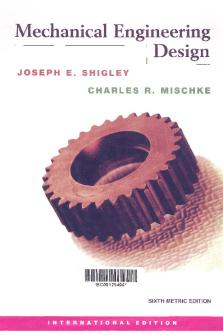
Mechanical engineering design
- 6 Pages
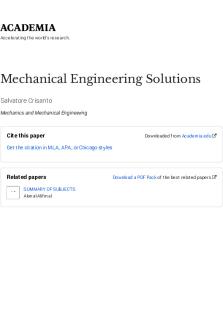
Mechanical Engineering Solutions
- 21 Pages

MECHANICAL ENGINEERING REVIEW MANUAL
- 509 Pages

MECHANICAL ENGINEERING REVIEW MANUAL
- 509 Pages

Chapter 7 Solution Manual
- 3 Pages

Chapter 7 Solution Manual
- 83 Pages
Popular Institutions
- Tinajero National High School - Annex
- Politeknik Caltex Riau
- Yokohama City University
- SGT University
- University of Al-Qadisiyah
- Divine Word College of Vigan
- Techniek College Rotterdam
- Universidade de Santiago
- Universiti Teknologi MARA Cawangan Johor Kampus Pasir Gudang
- Poltekkes Kemenkes Yogyakarta
- Baguio City National High School
- Colegio san marcos
- preparatoria uno
- Centro de Bachillerato Tecnológico Industrial y de Servicios No. 107
- Dalian Maritime University
- Quang Trung Secondary School
- Colegio Tecnológico en Informática
- Corporación Regional de Educación Superior
- Grupo CEDVA
- Dar Al Uloom University
- Centro de Estudios Preuniversitarios de la Universidad Nacional de Ingeniería
- 上智大学
- Aakash International School, Nuna Majara
- San Felipe Neri Catholic School
- Kang Chiao International School - New Taipei City
- Misamis Occidental National High School
- Institución Educativa Escuela Normal Juan Ladrilleros
- Kolehiyo ng Pantukan
- Batanes State College
- Instituto Continental
- Sekolah Menengah Kejuruan Kesehatan Kaltara (Tarakan)
- Colegio de La Inmaculada Concepcion - Cebu

